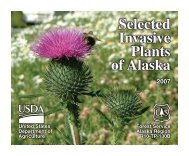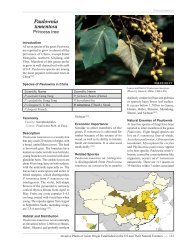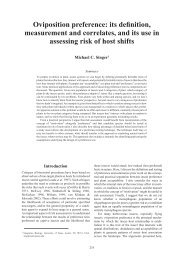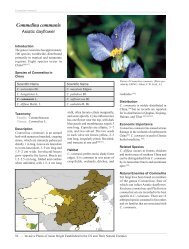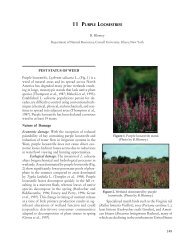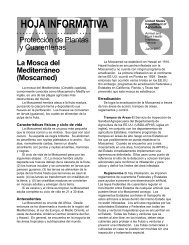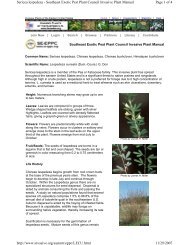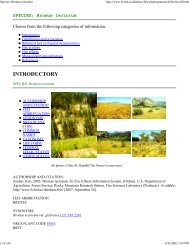A review of literature and field practices focused on ... - Invasive.org
A review of literature and field practices focused on ... - Invasive.org
A review of literature and field practices focused on ... - Invasive.org
Create successful ePaper yourself
Turn your PDF publications into a flip-book with our unique Google optimized e-Paper software.
edge. The farmer said that he occasi<strong>on</strong>ally used a bulldozer to push the knotweed back<br />
over the stream bank. Knotweed also formed small col<strong>on</strong>ies (ca. 1-5 m2) in the interior<br />
<str<strong>on</strong>g>of</str<strong>on</strong>g> a hay <str<strong>on</strong>g>field</str<strong>on</strong>g> where it appeared to have been treated with herbicide in 2003 (Kiviat <str<strong>on</strong>g>and</str<strong>on</strong>g><br />
Jennifer Hanink, pers<strong>on</strong>al observati<strong>on</strong>s, 2003). Possibly rhizome or stem fragments<br />
were transported accidentally by farm equipment <str<strong>on</strong>g>and</str<strong>on</strong>g> provided the propagules for these<br />
infestati<strong>on</strong>s.<br />
On amenity values- Knotweed could obscure the view <str<strong>on</strong>g>of</str<strong>on</strong>g> the stream channel at certain<br />
locati<strong>on</strong>s. Also, some pers<strong>on</strong>s might c<strong>on</strong>sider the dead st<str<strong>on</strong>g>and</str<strong>on</strong>g>ing canes unattractive<br />
during the dormant seas<strong>on</strong>.<br />
Riparian Habitats<br />
Rivers can disperse many invasive species, including Japanese knotweed. In additi<strong>on</strong>,<br />
flooding causes periodic disturbances (scouring, sediment depositi<strong>on</strong>) <str<strong>on</strong>g>and</str<strong>on</strong>g> some<br />
invasive plants are adapted to col<strong>on</strong>ize disturbed areas. Japanese knotweed can form<br />
dense st<str<strong>on</strong>g>and</str<strong>on</strong>g>s <strong>on</strong> riverbanks <str<strong>on</strong>g>and</str<strong>on</strong>g> in intermittently wet areas. These st<str<strong>on</strong>g>and</str<strong>on</strong>g>s can displace<br />
native vegetati<strong>on</strong>, <str<strong>on</strong>g>and</str<strong>on</strong>g> make access to the riverbank more difficult for angling <str<strong>on</strong>g>and</str<strong>on</strong>g> other<br />
activities. Japanese knotweed is believed to exacerbate flooding by clogging river <str<strong>on</strong>g>and</str<strong>on</strong>g><br />
stream channels with its large (presumably both live <str<strong>on</strong>g>and</str<strong>on</strong>g> dead) stalks thus decreasing<br />
water flow through the channels (Child et al. 1992, Seiger 1996; Trevor Renals,<br />
pers<strong>on</strong>al communicati<strong>on</strong>, 2002). The sparse winter canopy cover <str<strong>on</strong>g>of</str<strong>on</strong>g> knotweed <str<strong>on</strong>g>and</str<strong>on</strong>g> the<br />
few associated plants leave bare soil exposed <str<strong>on</strong>g>and</str<strong>on</strong>g> vulnerable to erosi<strong>on</strong> (Child et al.<br />
1992). Knotweed, however, was planted for erosi<strong>on</strong> c<strong>on</strong>trol in C<strong>on</strong>necticut (Peter<br />
Pic<strong>on</strong>e, C<strong>on</strong>necticut Department <str<strong>on</strong>g>of</str<strong>on</strong>g> Envir<strong>on</strong>mental Protecti<strong>on</strong>, presentati<strong>on</strong> 29 March<br />
2003, Cornwall, CT).<br />
When a large flood occurred <strong>on</strong> the St. Austell River in Cornwall, U.K., it was noticed<br />
that the largest Japanese knotweed infestati<strong>on</strong>s al<strong>on</strong>g that river were where the most<br />
scouring <str<strong>on</strong>g>and</str<strong>on</strong>g> the most depositi<strong>on</strong> had occurred (Trevor Renals, pers<strong>on</strong>al<br />
communicati<strong>on</strong>, 2002). It is unclear, however, whether scoured areas provided<br />
favorable habitat for knotweed col<strong>on</strong>izati<strong>on</strong> or knotweed-col<strong>on</strong>ized areas eroded faster.<br />
Scoured areas might collect vegetative propagules <str<strong>on</strong>g>of</str<strong>on</strong>g> knotweed during floods.<br />
C<strong>on</strong>tinual erosi<strong>on</strong> might also stimulate rhizomes, resulting in prolific knotweed growth.<br />
Large knotweed canes in a highly scoured area tend to be washed out <str<strong>on</strong>g>and</str<strong>on</strong>g> deposited in<br />
areas <str<strong>on</strong>g>of</str<strong>on</strong>g> fine substrate, ideal for growth, or in other highly scoured areas. Knotweed<br />
growth could also increase depositi<strong>on</strong> by trapping sediment during overbank floods. At<br />
the same time knotweed can increase the severity <str<strong>on</strong>g>of</str<strong>on</strong>g> a flood event because the litter can<br />
be swept downstream <str<strong>on</strong>g>and</str<strong>on</strong>g> block flood channels. By increasing flood severity, knotweed<br />
may increase, as viable canes are spread farther (Trevor Renals, pers<strong>on</strong>al<br />
communicati<strong>on</strong>, 2002). Knotweed thus might alter sedimentati<strong>on</strong> patterns in a river by<br />
increasing or decreasing either erosi<strong>on</strong> or depositi<strong>on</strong> (Trevor Renals, pers<strong>on</strong>al<br />
communicati<strong>on</strong>, 2002).<br />
Erik Kiviat supplied the following commentary <strong>on</strong> the above secti<strong>on</strong> when recently<br />
c<strong>on</strong>tacted (Erik Kiviat, Huds<strong>on</strong>ia, Ltd., pers<strong>on</strong>al communicati<strong>on</strong>, February 2006):<br />
We have observed following floods (e.g. in 2005) that there is c<strong>on</strong>siderable depositi<strong>on</strong><br />
<str<strong>on</strong>g>of</str<strong>on</strong>g> fine sediment <strong>on</strong> the floodplain surface within Japanese knotweed st<str<strong>on</strong>g>and</str<strong>on</strong>g>s in at least<br />
some areas. It is possible that sediment deposits am<strong>on</strong>g knotweed stems <strong>on</strong> the<br />
floodplain surface whereas streambanks dominated by knotweed eroded by<br />
7




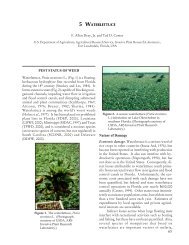

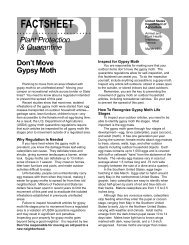
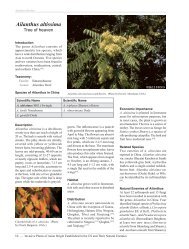
![A Guide to the Control and Management of Invasive Phragmites [PDF]](https://img.yumpu.com/27321025/1/190x190/a-guide-to-the-control-and-management-of-invasive-phragmites-pdf.jpg?quality=85)
